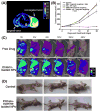Photodynamic nanomedicine in the treatment of solid tumors: perspectives and challenges
- PMID: 23474028
- PMCID: PMC3780355
- DOI: 10.1016/j.jconrel.2013.02.020
Photodynamic nanomedicine in the treatment of solid tumors: perspectives and challenges
Abstract
Photodynamic therapy (PDT) is a promising treatment strategy where activation of photosensitizer drugs with specific wavelengths of light results in energy transfer cascades that ultimately yield cytotoxic reactive oxygen species which can render apoptotic and necrotic cell death. Without light the photosensitizer drugs are minimally toxic and the photoactivating light itself is non-ionizing. Therefore, harnessing this mechanism in tumors provides a safe and novel way to selectively eradicate tumor with reduced systemic toxicity and side effects on healthy tissues. For successful PDT of solid tumors, it is necessary to ensure tumor-selective delivery of the photosensitizers, as well as, the photoactivating light and to establish dosimetric correlation of light and drug parameters to PDT-induced tumor response. To this end, the nanomedicine approach provides a promising way towards enhanced control of photosensitizer biodistribution and tumor-selective delivery. In addition, refinement of nanoparticle designs can also allow incorporation of imaging agents, light delivery components and dosimetric components. This review aims at describing the current state-of-the-art regarding nanomedicine strategies in PDT, with a comprehensive narrative of the research that has been carried out in vitro and in vivo, with a discussion of the nanoformulation design aspects and a perspective on the promise and challenges of PDT regarding successful translation into clinical application.
Copyright © 2013 Elsevier B.V. All rights reserved.
Figures




References
-
- Cancer Fact Sheet. http://www.who.int/mediacentre/factsheets/fs297/en/index.html.
-
- Maeda H, et al. Tumor vascular permeability and the EPR effect in macromolecular therapeutics: a review. J Control Release. 2000;65:271–284. - PubMed
-
- Fang J, et al. The EPR effect: Unique features of tumor blood vessels for drug delivery, factors involved, and limitations and augmentation of the effect. Adv Drug Deliv Rev. 2011;63:136–51. - PubMed
-
- Maeda H. The enhanced permeability and retention (EPR) effect in tumor vasculature: the key role of tumor-selective macromolecular drug targeting. Adv Enzyme Regul. 2001;41:189–207. - PubMed
Publication types
MeSH terms
Substances
Grants and funding
LinkOut - more resources
Full Text Sources
Other Literature Sources

